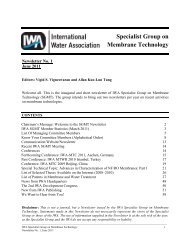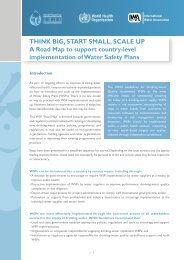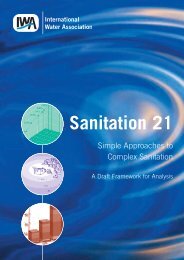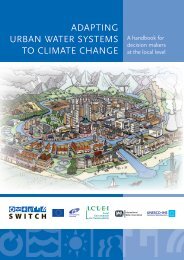Specialist Group on Use of Macrophytes in Water Pollution ... - IWA
Specialist Group on Use of Macrophytes in Water Pollution ... - IWA
Specialist Group on Use of Macrophytes in Water Pollution ... - IWA
Create successful ePaper yourself
Turn your PDF publications into a flip-book with our unique Google optimized e-Paper software.
AREA AND ENERGY REQUIREMENTS: COMPARISON BETWEEN CEPT-CWL,<br />
TIDAL FLOW CWL AND FRENCH DESIGN CWL SYSTEMS FOR THE REMOVAL<br />
OF ORGANICS AND NITROGEN COMPOUNDS<br />
Eil<strong>on</strong> Guthman, Sheld<strong>on</strong> Tarre and Michal Green<br />
Techni<strong>on</strong>, Israel Institute <strong>of</strong> Technology, Haifa, 32000 Israel<br />
Background<br />
In smaller communities the envir<strong>on</strong>mental friendly, low cost and l<strong>on</strong>g-lived technology <strong>of</strong><br />
c<strong>on</strong>structed wetlands becomes more and more important. However, the large land demand<br />
with the accompany<strong>in</strong>g water loss and <strong>in</strong>creased sal<strong>in</strong>ity due to the high evaporati<strong>on</strong> rate<br />
typical to Mediterranean countries, limit the applicati<strong>on</strong> <strong>of</strong> this technology, especially when<br />
effluent re-use is practiced or desired. Moreover, while the efficiency <strong>of</strong> c<strong>on</strong>structed wetlands<br />
<strong>in</strong> the removal <strong>of</strong> BOD and TSS is very high, nitrogen removal <strong>in</strong> most <strong>of</strong> the present<br />
generati<strong>on</strong> <strong>of</strong> operat<strong>in</strong>g wetland systems (predom<strong>in</strong>antly horiz<strong>on</strong>tal flow beds) is deficient,<br />
ma<strong>in</strong>ly because <strong>of</strong> poor nitrificati<strong>on</strong> due to <strong>in</strong>sufficient oxygen supply. Treated domestic<br />
wastewater without nutrient removal can be beneficial for agricultural use, but unfortunately,<br />
this water cannot be released unc<strong>on</strong>trolled to the envir<strong>on</strong>ment due to their negative effect <strong>on</strong> the<br />
envir<strong>on</strong>ment: eutrophicati<strong>on</strong>, c<strong>on</strong>tam<strong>in</strong>ati<strong>on</strong> <strong>of</strong> groundwater, amm<strong>on</strong>ia toxicity, etc. In Israel<br />
where currently about 70% <strong>of</strong> the wastewater produced is reclaimed for agricultural reuse, a<br />
new standard for unrestricted irrigati<strong>on</strong>, known as Inbar regulati<strong>on</strong>s have been approved<br />
(Inbar, 2007). Am<strong>on</strong>g others, the regulati<strong>on</strong>s dictate (average values): COD=100 mg/l;<br />
TSS=10mg/l; TN=25 mg/l; NH4-N=20 mg/l; Total P=5 mg/l.<br />
Hav<strong>in</strong>g <strong>in</strong> m<strong>in</strong>d the ma<strong>in</strong> disadvantages <strong>of</strong> extensive systems <strong>in</strong> general and c<strong>on</strong>structed<br />
wetlands (CWL) specifically, i.e. large land requirements, water loss and <strong>in</strong>creased sal<strong>in</strong>ity<br />
and poor nutrients removal, and <strong>in</strong> order to comply with the Israeli Inbar regulati<strong>on</strong>s, a new<br />
CEPT-CWL system was <strong>in</strong>vestigated. This system is characterized by the ma<strong>in</strong> advantages <strong>of</strong><br />
extensive systems (c<strong>on</strong>structed wetlands) <strong>in</strong>clud<strong>in</strong>g simplificati<strong>on</strong>; cost effectiveness; and<br />
reliability, with the additi<strong>on</strong>al important advantages <strong>of</strong> nutrients (N, P) removal and m<strong>in</strong>imal<br />
land requirement. The system c<strong>on</strong>sists <strong>of</strong> chemically enhanced primary treatment (CEPT) that<br />
significantly reduces the organic load <strong>on</strong> the succeed<strong>in</strong>g units, followed by the use <strong>of</strong><br />
c<strong>on</strong>structed wetland units for nitrificati<strong>on</strong> and denitrificati<strong>on</strong> with recirculati<strong>on</strong> between the<br />
two units. In additi<strong>on</strong> to reduc<strong>in</strong>g the organic load, the removal <strong>of</strong> COD and suspended solids<br />
by CEPT results <strong>in</strong> an effluent with a C to N ratio more suited for nitrificati<strong>on</strong> and less pr<strong>on</strong>e<br />
to wetland clogg<strong>in</strong>g. The process is characterized by low energy <strong>in</strong>put s<strong>in</strong>ce the oxygen<br />
requirement for the removal <strong>of</strong> the organic matter is m<strong>in</strong>imized (most <strong>of</strong> the residual COD is<br />
used as the electr<strong>on</strong> d<strong>on</strong>or for denitrificati<strong>on</strong>).<br />
This article focuses <strong>on</strong> the area and energy requirements <strong>of</strong> the CEPT-CWL system <strong>in</strong><br />
comparis<strong>on</strong> to two other well known CWL system variati<strong>on</strong>s claim<strong>in</strong>g nitrogen removal: the<br />
‗tidal flow‘ wetland system (nitrificati<strong>on</strong> and denitrificati<strong>on</strong>) (Aust<strong>in</strong> et al., 2003, 2006) and<br />
the ‗French design‘ system (nitrificati<strong>on</strong> with m<strong>in</strong>imal denitrificati<strong>on</strong>) (Molle et al., 2008;<br />
Molle et al., 2005).<br />
____________________________________________________________________________________________________<br />
<strong>IWA</strong> <str<strong>on</strong>g>Specialist</str<strong>on</strong>g> <str<strong>on</strong>g>Group</str<strong>on</strong>g> <strong>on</strong> <strong>Use</strong> <strong>of</strong> <strong>Macrophytes</strong> <strong>in</strong> <strong>Water</strong> Polluti<strong>on</strong> C<strong>on</strong>trol: Newsletter No. 38 31

















